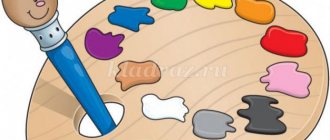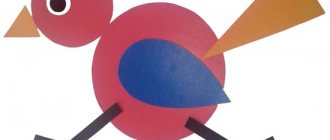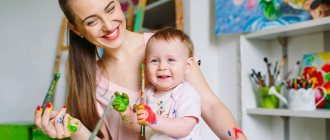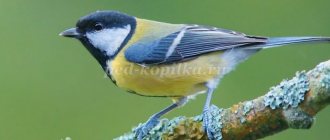On the topic: methodological developments, presentations and notes
direction of work: artistic and aesthetic.
Program content: teach children to combine different techniques of drawing paths with pencils and sculpting a kolobok in the shape of a ball, arouse interest in reviving the kolobok (beady eyes), teach how to roll a ball.
Goal: to develop the ability of children to sculpt rowan berries from plasticine, pinching small pieces from a large one and rolling them into small balls. Objectives: to teach children to connect berries into a bunch, to form int.
Summary of a modeling lesson on the topic: “Kolobok” in the first junior group.
Summary of a modeling lesson on the topic “Banana” in the first junior group.
Goal: - To form a holistic picture of the world during children’s productive activities. Tasks: - to develop the ability to work with plasticine. - To continue to introduce children to the concepts of “circle”, .
Goal: - To form a holistic picture of the world during children’s productive activities. Tasks: - to develop the ability to work with plasticine. - To continue to introduce children to the concepts of “circle”, .
material for teachers of younger groups. complies with Federal State Educational Standards
Summary of a modeling lesson in the first junior group "Transport"
Yakimova Polina
Summary of a modeling lesson in the first junior group "Transport"
Modeling lesson in the first junior group.
Yakimova Polina.
The theme of the week is “Transport”.
The topic of the lesson is “Repairing a truck.”
Goal: get acquainted with the concept of “Truck”; find out what it consists of and what it is intended for.
Tasks:
Develop thinking, visual perception, attention, memory.
Develop cognitive interest.
Arouse interest in modeling.
Develop fine motor skills of the hands, coordinate the work of both hands.
To cultivate in children responsiveness, kindness, the ability to sympathize with characters, and the desire to help them
Materials for the lesson: toys: truck, cat; pictures of a truck without wheels; plasticine.
Progress of the lesson.
Surprise moment.
There's a knock on the door. A truck with a toy cat in the back drives into the group.
Educator
: “Guys, look who came to us. This is Vaska the cat, he wants you to take him for a ride in the car. Shall we go for a ride?
The children take turns giving the cat a ride in the car.
Educator:
“Guys, sit down on the chairs, and we will carefully look at the car in which the cat came to us. What does it consist of? What colour? What is the name of?"
The children sat down on the chairs.
Educator:
“What does a car consist of? Cabin, body, wheels. What colour?"
The cab is red, the body is yellow, the wheels are black.
Educator:
“Do you know what the body is needed for?
To transport various cargo ( we show pictures of a loaded car
).
And if a car is designed to transport cargo, what is it called? Lorry or TRUCK.”
Educator:
“Vaska the cat wants to play with us, he will tell us a rhyme, and we will show this rhyme.”
The children get up from their chairs and do a warm-up.
I am a working machine (we stomp our feet in place)
Here is my body and cabin (we take turns stretching our palms forward
)
I'm heavy, I'm big (tiptoe up)
Do you know how powerful I am (we show “strength” with our hands)
I’m used to carrying loads (we show the steering wheel with our hands)
Who, I tell you? TRUCK!
Educator:
“Guys, our cat has not just one truck, but whole...
(according to the number of children)
. But for some reason these trucks just can’t go. Let's see what's wrong with them."
The teacher shows pictures of trucks that have no wheels.
Educator
: “Guys, what don’t these trucks have, why don’t they drive?
That's right, they don't have wheels. Let's repair them - give them new wheels.
If Vaska the cat likes the new wheels, he will leave his truck in our group.”
We take out plasticine and sculpt from it the missing wheels in the pictures.
Did we help our cat and repair the truck? The cat is very happy. For this he will tell us a verse:
No, we shouldn't have decided
Ride a cat in a car:
The cat is not used to riding -
The truck overturned.
And he gives you his truck.
Summary of educational activities for modeling in the second junior group “Let's repair the car”
Elena Sheveleva
Summary of educational activities for modeling in the second junior group “Let's repair the car”
Abstract of the GCD for modeling in the second junior group “ Let's repair the car ”
Topic: Let's repair the car .
Objectives: To arouse interest in modeling . Teach children to make a ball and slightly flatten it with the palm of their hand into a disk to form a wheel. Develop fine motor skills of the hands, coordinate the work of both hands. To cultivate in children responsiveness, kindness, the ability to sympathize with characters, and the desire to help them.
Progress of activities:
Bunny comes to visit the children.
Z. - Hello guys. Do you recognize me? Who am I? That's right, Bunny. I came to congratulate you on the beginning of the school year. I wanted to go visit the bear today and congratulate him, do you want to come with me?
Z. – “My truck is a truck ,
Here is the cab, steering wheel and body,
She needs the body for cargo.
Bunny sitting in the back
He's looking at the wheels."
V. - Guys, look what happened to Zayka’s car ?
Z. - What should I do now?
V. – Don’t worry, Bunny, we have a workshop and the guys will be able to fix your car . Guys, can we help Bunny?
V. - Guys, can we go to them? Why? What should be done? What wheel shape?
— To repair our cars , we need to warm our hands.
“We took plasticine into our hands
And we drove around a little
And then pressed lightly
And we weren’t at all tired.”
V. – Look carefully at how you and I will make wheels. First we will roll out a piece of plasticine. Then we apply it to the car and press lightly . What happened? These are the wheels you will attach to your car .
Pay attention to the sequence of work.
You can start working.
Independent work of children.
Offer to go to the forest in cars .
Physical education lesson: The song “ Machine ”
Children imitate the movements of driving a car .
Approaching the “den”
where the bear sleeps. They wake him up.
The game “At the Bear in the Forest”
.
Notes on sculpting "Sun" in the second junior group Notes on sculpting "Sun" in the 2nd junior group Purpose: to learn how to sculpt simple objects consisting of several parts of different shapes.
Abstract of the GCD for sculpting in the second junior group “Mouse-norushka” Program content: Educational objectives: Teach children to sculpt a mouse based on an egg-shaped shape. Show ways to create expressiveness.
Abstract of educational activities on object modeling in the second junior group “Cheerful Tumbler” Integration of educational areas: artistic and aesthetic development, social and communicative development; speech development, cognitive.
Notes on traffic rules in the second junior group “I’ll start my car” Materials and equipment: cars and trucks, a box of beans, figures of pedestrians (men from the LEGO set, model “On the streets.
Summary of the GCD lesson on sculpting “Make the Sun” in the second junior group Summary of GCD lesson on sculpting “Make the Sun” in the 2nd junior group Shaykhavova R. A. Goal: learn to sculpt simple objects consisting of several.
Notes on sculpting in the second junior group “This amazing underwater world!” Topic: “This amazing underwater world!” (plot modeling). Age group: second youngest. Type of activity: productive activity. Summary of GCD for modeling in the second junior group “Dymkovo Ducks” Objectives: 1. Continue to introduce children to the Dymkovo pattern 2. Develop the ability to make a traditional pattern 3. Cultivate a love for.
Summary of GCD for sculpting in the second junior group “Tank” GCD for sculpting in the second junior group. Topic: "Tank". Goal: to consolidate the ability to sculpt a tank from separate parts, to correctly convey the shape.
Source





